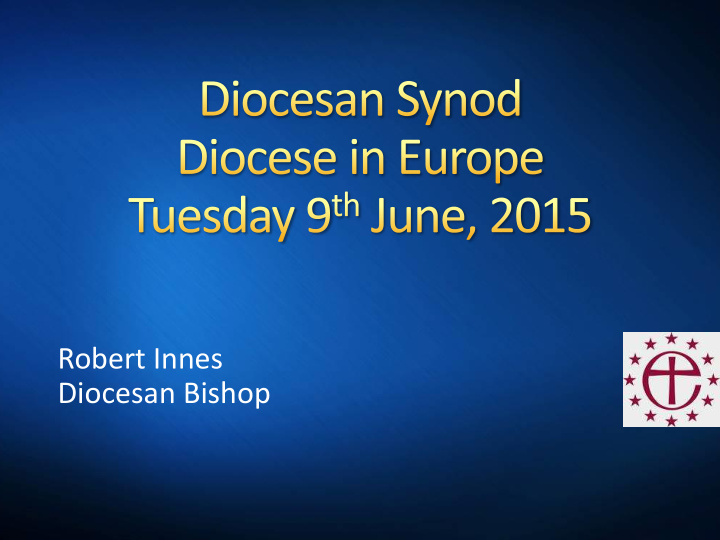



Robert Innes Diocesan Bishop
Developments in the Church of England nationally A look at our recent past – the context for where we are now The strategy – why, how and who The strategy – what it is
From Anecdote to Evidence (2011-2013) “This is a moment of great opportunity for the Church of England” (The Archbishops of Canterbury and York (Jan 2015)
1. Developing Discipleship Promoting the discipleship of the whole people of God Commending 10 marks of a Diocese committed to developing disciples Fresh theological resources on making disciples A revised catechism for the C. of E.
2. Resourcing Ministerial Education 40% of clergy will retire in the next 10 years Dioceses want to keep current clergy levels Quality of leadership is a key factor in growth Therefore, plan on a 50% increase in ordinations from 2013 to 2020 then sustained for 10 years Plan on the rapid development of lay ministries
3. Resourcing the Future Abandoning current formula-based approaches which incentivise decline Half of central funding to go to the poorest areas Half of central funding to be invested in new growth opportunities More central funding from the Church Commissioners is requested
4. Simplication A raft of proposals to reduce bureaucracy and facilitate flexibility and mission in: The appointment of clergy Pastoral reorganisation Management of buildings
5. Breaking the Commissioners promise on Inter-Generational Equity An awareness that the future of the church is gravely threatened Recognition that recent Church Commissioners investment performance has been very good A proposal to spend heavily at this point to support current ambitious investment proposals
Prayer and the religious life Reconciliation Evangelism and witness
….Turning to look at our own diocese….
Strategic Review Group 2008-2010 Pastoral and Mission Statistics Working Group (chaired by Ann Turner) Legal and Finance Group (chaired by David Gowan) Major report presented at the 2010 Synod
2008 average October Sunday attendance of 12,384 – ‘a growing diocese’ 52% of attendees have an Anglican/Episcopal background Significant age profile differences across archdeaconries and ‘retirement’ vs. ‘city’ parishes 83% of attenders live within 20km of their place of worship
People find out about church through friends (35%) and the internet (13%) We have significant numbers of local language speakers in NW Europe and Germany There is much scope for growth throughout the diocese even if we only attract 2% of UK nationals Survey commended by Prof. Silverman Recommendation that the survey is repeated every 5 years
Preparation of Archbishops’ Instruments to regularise the status of the diocese Commendation of a pastoral structure of: A second suffragan bishop (later dropped) Four free-standing archdeacons Wide use of Area Deans
Funding of Archdeacons, either: 4 funded locally, or 2 funded locally and 2 funded by the Commissioners First F/t archdeacon to be appointed 2012 Financial realism: “If we cannot fund the proposed change it cannot be implemented”
Disappointment over Commissioners’ funding for 4 archdeacons (2013) Retirement of Bishop Geoffrey (2013) Description of the diocese prepared by the Vacancy in See Committee (2013/4) Role specification for the new bishop prepared by the national church (2013/14) Appointment of new bishop (from September 2014)
Extensive consultation was carried out by the national church prior to the appointment A review of location was offered by the Bishop of London but postponed Appointing process: “accommodation for the bishop will be moved from Worth” “The new bishop will need to be prepared to live in Europe...” Discussion between me and the appointing (arch)bishops led to agreement on Brussels A review of ‘offices and residences’ remains on the table
….turning now to the strategy itself… …the why and the what…
Previous good work on strategic planning within the diocese An emphasis within the national church on strategic thinking Bonding of our own diocese within national structures Linking of central funding to strategic analysis A priority for the new bishop
A ‘bottom up’ approach Bishop’s Council day meeting on strategy facilitated by Sandra Cobben October 2014 Strategy working group facilitated by David Coulson December 2014 Bishop’s Staff Meeting Presentation January 2015 A second strategy group meeting in Brussels Trialling at Archdeaconry synods
Strategy working group members: The two bishops Patrick Curran Debbie Flach Jack McDonald Ann Turner David Coulston (convenor) Grace West (one meeting only) Diocesan Secretary
Our aim is to build a common purpose throughout the diocese by: Knowing ourselves as beloved children of God Loving God and our neighbour and sharing the Good News of Jesus Christ Generating a sense of shared direction in the power of the Holy Spirit Providing a focus for all that we do.
Within the Anglican tradition through each congregation and in partnership with other Churches by: Encouraging and supporting the vocation of all the baptized Deepening faith and practice in prayer and worship Teaching the faith and promoting Christian education Nurturing new disciples, especially young people
Proclaiming the Good News Valuing and promoting a culture of welcome, invitation & hospitality Seeking opportunities for growth
Defending the poor, the disadvantaged, and those in need Promoting a discipline and culture of safeguarding Combatting slavery and human trafficking Challenging the comfortable Encouraging care for the creation
Within the Church at all levels Among nations, ethnicities & religions Through intentional engagement with European and international institutions
Stewardship of our gifts and talents Increasing numbers of full-time clergy and candidates for ordained ministry, focusing on Recruitment Retention Resources Well-structured archdeaconries
Robert Innes Diocesan Bishop
Recommend
More recommend